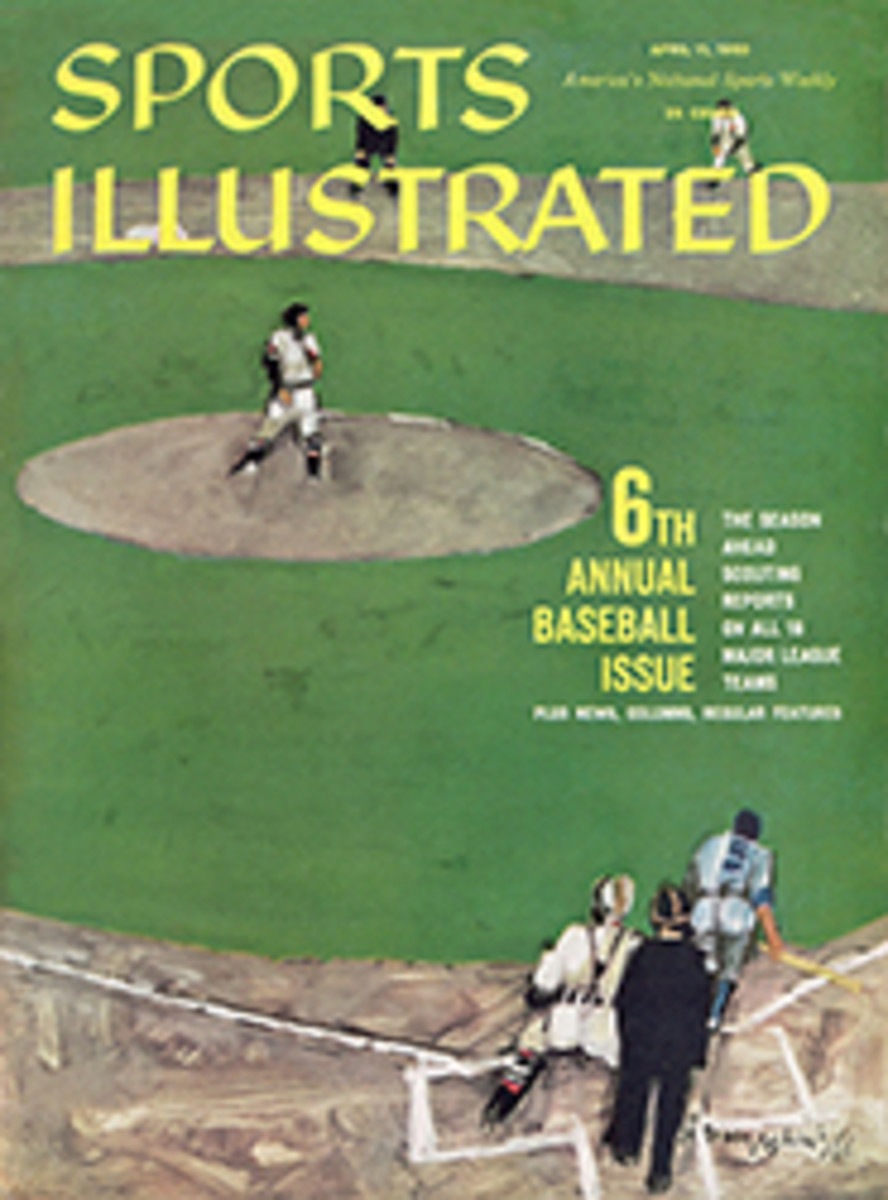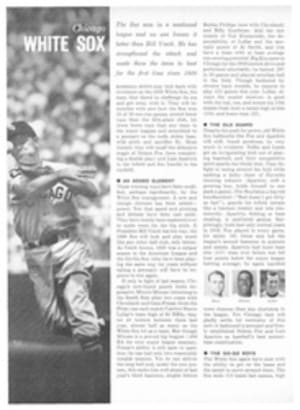
Boston RED SOX
There was one glorious moment this spring. The Boston Red Sox were playing the Chicago Cubs in Mesa, Ariz. It was an hour or so before game time and Ted Williams was taking batting practice. Williams hit the first pitch high in the air, over the right-field fence. The Cubs, sitting in their dugout, watched in silence. The second pitch was hit the same way, just as far. So was the third. Williams hit the fourth pitch on a line past first, then lifted the fifth and last over the fence again.
"I'll be darned," said one of the Cubs, "if that guy doesn't play this park like a pitch-and-putt."
•TED AND JENSEN
Ted Williams may be 41 and his neck may hurt, but he is still the most impressive thing about the Red Sox. When he hits a ball right, even now, it is better than Gene Stephens or Marty Keough or Gary Geiger will ever hit one. Admittedly, his value to the team is questionable. He cannot run and he cannot throw, so he must hit at least .320 to compensate. But even if he does not hit .320—and let somebody else bet that he won't—it is worthwhile having him around, if only to please the memory.
Jackie Jensen, of course, will not be around. Only 32 and in full bloom, Jensen won more publicity retiring from baseball than he ever did while playing it. When the Red Sox arrived in Las Vegas for an exhibition game this spring, Jensen was there in his civvies to greet them. He said he did not think he would miss playing baseball, but baseball, especially the Red Sox, will miss Jackie Jensen. He was an able right fielder and a powerful hitter. He drove in over 100 runs a season in five of his six years with Boston and the Red Sox will not find it easy without him.
•NIXON AND WHITE
Much as the absence of Jensen will hurt the Red Sox, the abrupt retirement of Catcher Sammy White will hurt even more. White was traded to Cleveland (and surely you must have read all the details) for the Cleveland catcher, Russ Nixon. Whereupon White, for business reasons, decided to give up the game. After a well-publicized cat fight between General Managers Bucky Harris and Frank Lane over who should keep Nixon, Commissioner Ford Frick ruled in favor of Lane. So Cleveland got Nixon and Boston was left with four catchers who between them have caught a total of 12 major league games. There was, of course, the possibility that the Red Sox would trade for a catcher with experience. If not they will probably open the season with Haywood Sullivan, a former football star in the Southeastern Conference, who a few years ago looked like a sure thing to make the Red Sox. Back trouble put him out of action during 1958, but now he seems hardy again. He has been pulling the ball well to left field, just the spot in Fenway Park. Defensively, he is not the handler of pitchers White was, but the Red Sox, surely in a storm, consider him the most convenient port.
The Red Sox catchers are huge. Sullivan is 6 feet 4, Don Gile is 6 feet 6, Jim Pagliaroni is 6 feet 3 and Ed Sadowski, the shrimp, is 5 feet 11. But you can bet the Red Sox would give them all, and a lot more, for someone named Berra.
•NOTHING AND NOTHING
The Red Sox have a pitching staff which is deep in mediocrity. There was a time when it looked as though Tom Brewer and Frank Sullivan, two strong-armed right-handers, would be as good as any pair of pitchers in the league. But in recent years they have won less and lost more until last year they both sank below the .500 level for the first time. Still, they are the best the team has. Ike Delock, when his temper is under control, is good, and Jerry Casale was 13-8 in his rookie year. Al Worthington and Tom Sturdivant are with the Red Sox now. In 1957 Sturdivant was the Yankees' biggest winner, but then he hurt his ankle during practice and never regained his form. The Red Sox got Dave Hillman from the Chicago Cubs this winter, but Hillman managed to crack himself up in an Arizona auto wreck during spring training, and no one is sure how effective he will be when he gets back into playing condition.
A covey of young pitchers lurks in the Boston brush and it is possible that one or two may be ready to do something big this year. Bill Monbouquette was 7 and 7 in 1959. Ted Bowsfield spent most of the season with Minneapolis, but looked impressive when his control was right. Ted Wills and Nelson Chittum were with Minneapolis, too, but were brought up to Boston during the season. Tom Borland, a good-looking left-hander also up from Minneapolis, seemed to be the best of the young lot.
•AND MALZONE
Half of the Boston infield is set. Frank Malzone will be at third base. He can hit, he can field and he's the best in the league at his position. Boston just wishes he were triplets. The most improved-looking player in training this spring was Don Buddin, the shortstop, who in past years has often made the hard plays only to fumble the easy ones. This spring he looked sure and his arm was accurate. At bat, he has become a thinker, a man who can do many things. He may be ready for a big year.
Of the other two positions, one thing is certain: Pete Runnels will play one of them. Runnels is no Malzone in the field but he can hit, and no hitter ever sat on the bench. If Vic Wertz is able to play a few games at first, Runnels will move to second. If Pumpsie Green can hit well for a stretch, Runnels will shift to first. If Ron Jackson, the tall right-handed first baseman the Sox got from Chicago, can start dropping a few over the short left-field wall, Runnels, an obliging sort, will return to second. But no matter who plays second and who plays first, the right side of the Boston infield will be defensively poor.
The Boston outfield will probably be the weakest in the league. Williams, whenever he plays, will be in left, just as he was 21 years ago. Gene Stephens will play center and left-center. For years Stephens, who is now third in seniority on the Red Sox, was the man who went in to field for Williams in the late innings. Last year he hit .278 and now, at 27, he seems ready to blow his own bugle. The vacancy Jensen created in right field will be filled, as much as is possible, by Gary Geiger and Marty Keough. When Williams does not play, Bobby Thomson, another ancient hero, will be the left fielder.
A word should be said about the youngster who almost certainly will be tomorrow's hero, Carl Yastrzemski. Boston fans may find his name hard to pronounce but they will not find him hard to take. He is 20, plays second base and hits left-handed. Last year, his first in professional baseball, he hit .377 and drove in 102 runs. This spring he hit better than most of the big boys. He was sent down to Minneapolis for added experience, but Boston fans can look forward to the day when he returns.
As for this year, they must content themselves with the bitter hope that if everything goes right, the Red Sox might finish as high as fifth again, instead of the more likely seventh.
[originallink:10497796:42161]
PHOTO
PHOTO
Runnels
PHOTO
Wertz
PHOTO
F. Sullivan
PHOTO
Brewer
PHOTO
Malzone
PHOTO
Stephens

